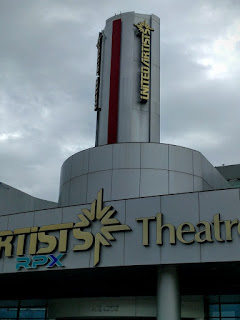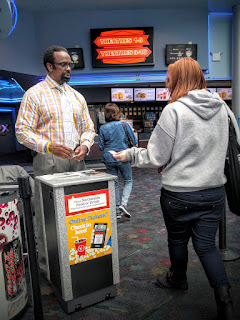I grew up singing along with the radio, “floats like a butterfly and stings like a bee.” Everyone knew that song, because everyone knew who the boxing heavyweight champion of the world was; whether it was during Muhammad Ali’s reign or George Foreman’s or Smokin’ Joe Frazier’s. In junior high, we talked at snack break about the fight on pay per view that we couldn’t afford to watch. On rainy days our P.E. teacher, Mr. Grey, would sometimes show ABC’s Wide World of Sports highlights reels, often featuring Ali (sometimes from back in his Cassius Clay days). The last time I knew the belt holder was in Mike Tyson’s day. When Ali passed away a few weeks ago, it felt like the death of that part of my childhood.
Which is why, when I saw that Michael Mann’s 2001 Ali was playing at a local theater in Staten Island, I knew it would be our New York theater film. (Actually, it wasn’t our first choice. We hoped to visit Nitehawk Theater in Brooklyn because it’s rated as one of the best theaters in New York on various polls and lists. But the show we wanted was sold out, so we didn’t see The Lobster there.)
But neither Mindy or I had seen Ali, which was acclaimed upon its release. Will Smith was deservedly nominated for the Oscar for Best Actor for his role as Ali. I thought it was a cool thing to re-release the film in honor of Ali’s passing, and the ticket tearer told us that after Prince died, the theater screened Purple Rain. I wish theaters did this kind of thing more often. Still, considering that we were the only ones attending our matinee show, I understand why they usually don’t.
Religion plays a big role in the film, as it did in Ali’s life. Much of America was shocked when Cassius Clay joined the Nation of Islam. Clay appears embarrassed by the Christian faith of his father, who painted blonde haired, blue eyed portraits of Jesus for African American churches. The Nation changed his name to Ali, but many Americans wouldn’t acknowledge the change. Ali faced even more opposition when he was drafted and refused to serve in Vietnam. When he faced prison time for that decision, the Nation of Islam excommunicated him; he was not allowed to go to the mosque to worship or communicate with other Black Muslims. The film also portrays another man excommunicated from the Nation of Islam, Malcolm X. (We see Malcolm preaching against turning the other cheek.) After Ali won his case before the Supreme Court, he was reinstated.
Best of all for this post, Ali was partially set and filmed in New York. We see the Apollo Theater and hear about the New York State Athletic Commission banning Ali for his decision to refuse the draft (though they did allow convicted murderers to fight). Admittedly, it is less difficult to find a New York film than a film made in most other states. But we almost went to see The Lobster at the Nitehawk, and it was filmed in Ireland.




No comments:
Post a Comment